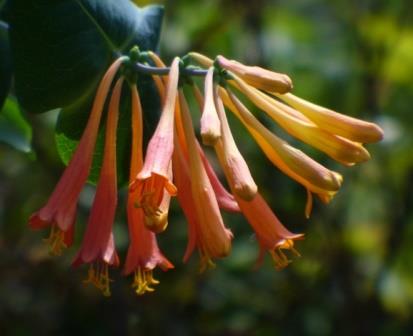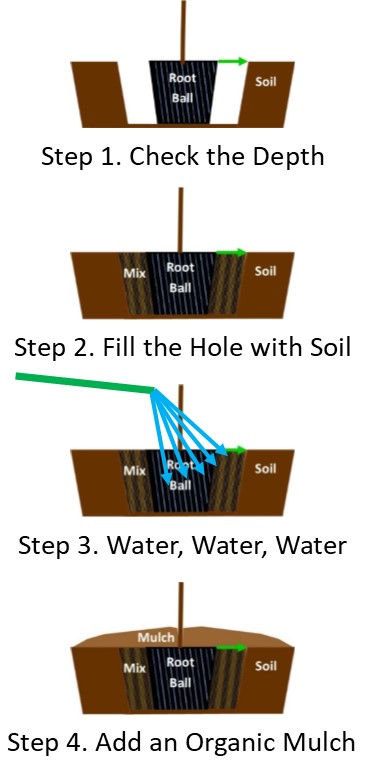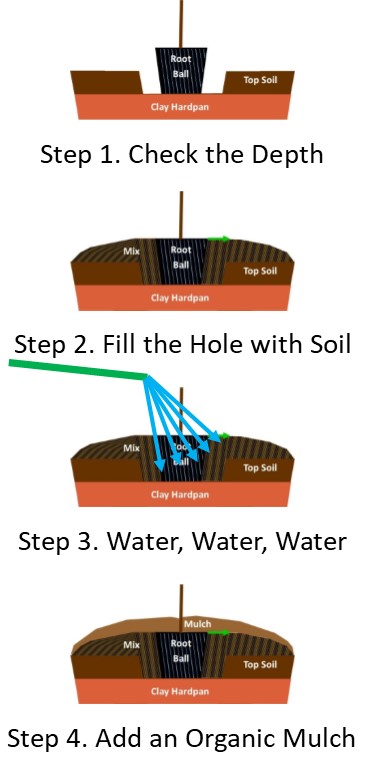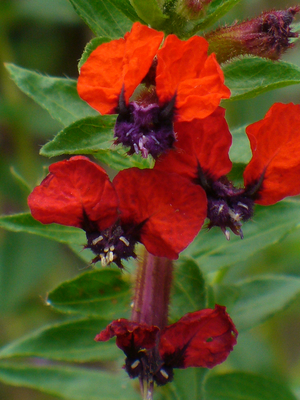Growing Coral Honeysuckle is for the Birds (and Butterflies, Pollinating Moths, and Bees)!
Almost Eden's Guide to Growing, Planting, Fertilizing, Training, and Pruning Honeysuckles (All types)
Note: all images in this guide are clickable if you need a larger version or would like to learn more about the plants pictured here
.jpg)
Coral or Trumpet Honeysuckle, Lonicera sempervirens
In its most common form the clusters of narrow, 2” long, tubular flowers of the Coral or Trumpet Honeysuckle, Lonicera sempervirens, are typically red to coral colored with newly opened flowers displaying bright yellow pollen and a yellow throat that becomes red as the flowers age and may have some dependency on successful pollination. Rare forms have been found with solid sunny yellow flowers, to orange, as well as in various shades of red. The flowers are a perfect fit for the bill of the Ruby Throat and other hummingbirds that share its range but flowers may also be visited by larger butterflies, some pollinating moths, as well as some species of larger bees. Larger bees are also known to rob pollen from still closed flowerbuds so if you see small round holes at the flower bud tip or base just know it is being utilized to its fullest extent. A green berry that ripens to a clear orange-red to red grows anywhere pollination was successful and eventually develops into a ¼” diameter or slightly larger, plump, round fruit. As with the flowers the fruit are often born in generous clusters that the songbirds will enjoy once they are fully mature. Deadheading to remove the berries will help to encourage growth and flowering, and can be helpful in getting young plants established as they expend their energy on establishment in lieu of fruit production. We find that when plants are in fruit, most other growing processes become secondary, and the differences can be significant.
Coral Honeysuckle produces its clusters of tubular flowers on new growth. Making sure that your plant has an ample amount of nutrients, sunlight, and moisture available for healthy growth will help to get it established and drawing in the hummingbirds quicker. As with many woody vines, Coral Honeysuckle can take 5 years or more to reach their full potential but by 3 it should already be putting on a good show. This tough, free-flowering, native vine seems like a teddy bear after dealing with its nasty cousin the Japanese Honeysuckle. It can grow to 12’ or a little higher if given support but it can also be maintained on a 3-4’ fence with minimal training. Pruning in our area is best done in late fall as the mature plants will try to grow new, albeit slower developing, flower clusters often starting in December. Minimal amounts of light pruning, occasional shaping, and periodic training will help to keep this vine in its designated space, if you so desire, but certainly is not a requirement.

Tangerine Princess Coral Honeysuckle
When adding woody vines to the landscape, we like to use sturdy, long-lasting materials. As with any tree or shrub, woody vines can develop into a weighty mass given enough time, although the Coral Honeysuckle’s twining stems weigh less than most even at peak maturity and at full fruit load. Does a hummingbird drinking from a blossom make the vine heavier I wonder? A durable long-lasting support will help your honeysuckle become a fixture in your garden where, given time and the appropriate growing conditions, it will begin to flower more and more with each passing year. We’ve seen them growing on a 6’ chain-link fence, along a 3’ picket fence, on 8-12’ lattice work, and up old cedar stumps with short limbs all to good effect. Most any long lasting, sturdy support that it can effectively twine around or through, still with room for the vine to grow in diameter, will be suitable.
Sunlight is what all of the plants are fighting about, elbowing their way past their neighbor for a better position for their solar panels and the Coral Honeysuckle is no different. Besides, woody vines are just lazy shrubs anyway sprawling, and wrapping themselves around, on top of, and through other plants to get to the best spot with no real support. Coral Honeysuckle will grow best where it gets full sun to most of a day of sun (preferably 8 hours or more). The Coral Honeysuckle is susceptible to powdery mildew but generally speaking it is not enough of a concern to spray for when plants are grown in full sun with reasonably good air circulation. In a shaded position or with poor air circulation, this white to gray fungus that develops on leaves, stems, and buds can sometimes become a concern and it is possible for plants to succumb to it under these conditions but the majority of the time they are likely to live over it.
Once fully established the Coral Honeysuckle is moderately drought tolerant but as with most plants from the eastern US it will grow and flower better if given the equivalent of 1” of rain per week. A moderate amount of available moisture is essential during the first year or two of establishment and may exceed the 1” per week average with newly planted vines. A breathable, organic mulch, will help to hold moisture in as well as to keep the weeds down. Organic mulch is likely all that these honeysuckles would receive in nature and has so many good qualities like soil temperature moderation, food for soil flora and fauna, nematode predator habitat, etc… that it should not be overlooked especially during the initial establishment period.
The Coral Honeysuckle’s botanical name is Lonicera sempervirens which translates to the evergreen honeysuckle but it seems to only remain mostly evergreen in the southern most portions of its range. It is considered native throughout much of the eastern US and as far west as central Texas and has been introduced into Canada. Locally we find it on well-drained, sandy, often acidic soils at the edges of the forest and along fencerows. When you look on the USDA Plants distribution for Coral Honeysuckle, it appears to be less prevalent in areas with alkaline soils. Some resources suggest that it will do okay even under mildly alkaline conditions though we haven’t tried it under those conditions. A well-draining, moderately fertile, loamy, acidic soil would be optimum for this easy, show-stopping, manageable climber.

Planting Steps for Soils with Average or Better Drainage

Planting Steps for Poorly Drained Soils or With Clay Hardpan
A quick note on planting and then I promise to stop rambling. Anytime that you receive a plant from our nursery it should already be growing at the correct soil depth in its container. In other words once you have finished thoroughly watering your new plants in after transplanting (3 times minimum according to John), the root ball’s soil surface should be even with the surrounding soil once everything has settled (see the diagram at left). If poor drainage is a concern the surrounding soil can be sloped up to meet the top of the root ball like on a pitcher’s mound (see the diagram at right). Tomatoes can be planted deeper successfully but they are generally the exception and not the rule and so it’s only a good idea to put a good organic mulch, like pine straw- our personal weed weapon of choice, on top of an intact root ball of acid loving, ornamental plants. If in transplanting the root ball ‘shatters’ and you end up with a stick and some roots do your best to replant it at the same depth it was previously appropriately spreading and firming soil in, around, and under the roots so as to securely support the top. If there is any doubt that the plant will not be firmly secure after a thorough watering it should be firmly staked. And then water it again to resettle the soil around any roots that may have been disturbed. Given the appropriate growing conditions Coral Honeysuckle should bring any passerby many seasons of enjoyment in flowers and feathered visitors. They are not hard to grow but do have their preference for sunlight and should do well in most average, well-drained garden soils. Give them a support and they will climb it, show them where you want them to go and they will follow until they can’t anymore and then they’ll just build on themselves and flower till the Hummingbirds come to quiet them down.
For our detailed "Planting a New Plant... Growing Guide" click here
Good resources for more information about Trumpet Honeysuckle, Lonicera sempervirens
North Carolina State University: https://plants.ces.ncsu.edu/plants/all/lonicera-sempervirens/
University of Florida Extension: http://edis.ifas.ufl.edu/fp354
Wildflower.org Native Plant Database: https://www.wildflower.org/plants/result.php?id_plant=LOSE
Woody Trees, Shrubs, and Vines of Louisiana: Charles M. Allen PhD, Dawn Allen Newman MS, and Harry Winters MD: click here
This guide applies to all types of Honeysuckles, not just Coral Honeysuckles, as far as growing, planting, pruning, and training are concerned.
For a printable or downloadable PDF version please (does not include the planting diagrams but these are clickable and can be printed seperately) click here.
If you have an additional questions or input please feel free to contact us.
Thank You & Good Growing,
Jeff McMillian
& The Crew at Almost Eden
![]()


-1.JPG)
.JPG)

-1.JPG)
